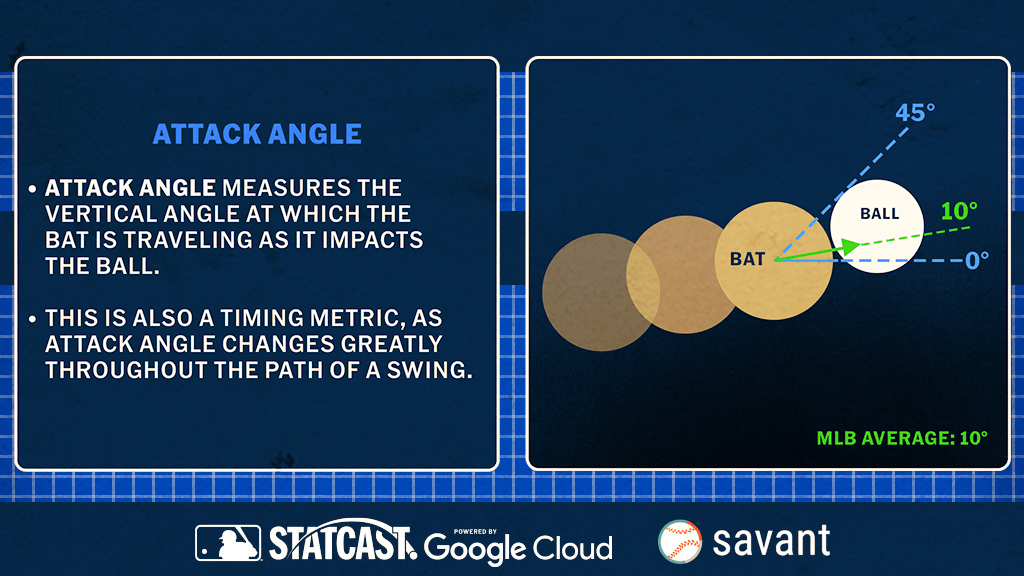Attack Angle
Definition
Attack angle measures the vertical direction that the sweet spot of the bat is traveling at the moment it hits the baseball.
Statcast's attack angle metric is reported at the point of contact specifically (or the point where the bat and ball cross paths, in the case of a swing-and-miss). It measures the angle the bat is moving relative to the ground.
A higher attack angle, assuming the bat makes square contact with the baseball, is more likely to result in a fly ball. A lower or negative attack angle would be more likely to produce a ground ball.

The MLB average attack angle is about 10°. On a seasonal level, Major League hitters will range from average attack angles of around 0° to 20°.
- Hitters with high attack angles include Max Muncy (18° in 2024), Eugenio Suárez (18°), Cal Raleigh (17°) and Jose Altuve (16°).
- Hitters with low attack angles include Brice Turang (1° in 2024) Vladimir Guerrero Jr. (3°), Steven Kwan (4°) and Jarren Duran (4°).
The ideal attack angle range for a hitter is from 5° to 20°. That is the range at which swings produce the most value for the batter.
Statcast measures both every hitter's average attack angle, and the percentage of his competitive swings that fall within the ideal attack angle range.
Attack angle and timing
Attack angle is in large part a timing metric, as the hitter’s attack angle is constantly changing throughout the course of the swing.
Early in the swing, for example, the attack angle will be negative as the barrel of the bat moves downward from the hitter’s starting point. At the end of the swing, during the hitter’s follow-through, the attack angle will be very high as the bat travels upwards. The number that Statcast reports is the attack angle at the point of contact specifically.
If a swing is in the ideal attack angle range, it means the hitter’s bat is moving at the optimal angle at the right time – when the bat and ball cross paths.
If a hitter mistimes his swing, though, he might have a much lower or higher attack angle. When the hitter is ahead of the pitch with his swing (i.e. too early), he will tend to have a higher attack angle. When the hitter is behind the pitch with his swing (i.e. too late), he’ll tend to have a lower attack angle.
Attack angle vs. other related metrics
Attack angle is reported together with attack direction. Attack angle is the vertical angle the sweet spot of the bat is traveling at the contact point, and attack direction is the horizontal direction the sweet spot is traveling at that same point.
But attack angle is different from other key Statcast metrics such as swing path (tilt) and launch angle.
- While swing path is about the shape of a swing on the way toward contact, attack angle tells you what is happening at contact.
- And while launch angle shows how the baseball is moving when it comes off the bat after contact, attack angle shows how the bat is moving when it impacts (or misses) the ball.
Statcast bat tracking data is available going back to the 2023 All-Star break.